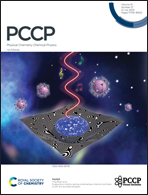Fluorescence probing and molecular docking analysis of the binding interaction of bovine serum albumin (BSA) with the polarity probe AICCN†
Abstract
In this work, the fluorescent probe 2-amino-4-(1H-indol-3-yl)-4H-chromene-3-carbonitrile (AICCN) has been used to evaluate its potential as a prospective polarity probe. From detailed fluorescence studies of the probe, it could be shown that AICCN can indeed function as an effective polarity probe. The calculated dipole moments of AICCN in both the ground state and excited state in various solvents lend support to the steady state fluorescence results. It was also shown that AICCN can be used to probe the micropolarity of micelles and can be used successfully for the determination of CMC of the surfactants. The binding process of the probe AICCN to BSA has been followed by plotting the binding isotherms and Scatchard Plots. The time-resolved fluorescence data indicate that the preferred binding site of AICCN in BSA lies close to the buried Trp residue Trp-213 in Domain II. This contention is further supported by the molecular docking studies. The interaction study of the probe AICCN with proteins is relevant for future use of AICCN as a hydrophobic drug. Information was also obtained about the effect of probe binding on the serum albumin structure, which may be correlated to its physiological activity. Thus, the probe AICCN can serve not only as a good reporter of polarity of the microenvironment in biological systems but also as an efficient fluorophore to monitor conformational changes in proteins in future.



 Please wait while we load your content...
Please wait while we load your content...